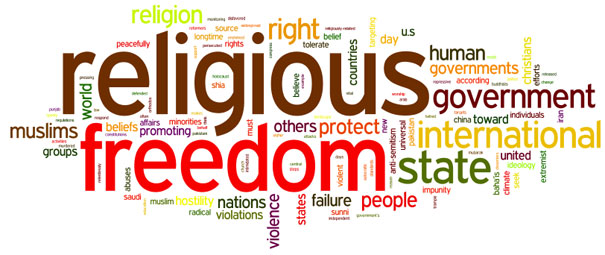
|
 |
 |
|
|
|
|
|
|
|
|
|
|
|
|
|
|
|
|
|
|
|
|
|
|
Freedom of Worship & Combating
|

|
But violence practiced by segments belonging to the religious majority, may easily target members of the same religion, under the pretext that those members are too moderate or do not sufficiently adhere to the tenets of religion. The prevalence of religious violence diminishes the space available for debate and criticism on religious issues. Thus, normal debate could lead to charging co-religionists holding a different view with blasphemy and even targeting them with violence, invoking the same justifications used against followers of other religions.
This invariably proves that protection of religious freedoms, freedom of worship and the recognition of religious groups, is not only a necessity for strengthening internal harmony in societies with diverse sects and denominations but is also a necessity to protect the religious majority from being harmed and fragmented by blind religious violence.
Violations of religious freedoms are often the trigger of all evils, because they can easily spill out into other political, social, cultural and service-related areas. Religious violence that claims to protect religion through disgraceful bloody acts, is not aware of the fact that religion does not need anyone’s protection. Protection is actually needed by human beings and citizens as they go about their daily life. How can the protection of religion, for instance, be served when someone hurls acid on the face of an unveiled woman?
The violent and bloody aggressiveness used against members of different religions, cannot be religiously justifiable or deemed as adherence to religious requirements. Otherwise, it would be possible to justify civil wars waged along sectarian lines, as well as collective assault and enslavement of women and subsequent sale in slave markets. In some cases, there are some who put this form of senseless violence in the context of sectarian historical wars, whether among Muslims or between Muslims and others. All this is used to conceal the current local political goals behind this violence.
There are non-religious factors, unrelated to history, which fuel and justify this religious violence. There are also some social groups or specific figures which regard religious violence as a means of securing political gains.
We must always pay attention to these factors, which may include: political tyranny; the existence of poverty and social, cultural, economic and political discrimination factors; the existence of official exclusion and marginalization policies against certain groups; inequalities between citizens; fragmentation of the social fabric; endemic corruption and political nepotism and widespread dissatisfaction with public policies. Under these conditions politicians may resort to converting political differences and basic human rights demands into sectarian and denominational differences.
Also Among the factors are the loss of trust in the state’s weak and ineffective institutions, the prevalence of a culture of impunity, denial of serious violations and the existence of sectarian charging pumps both external and internal, through religious and media channels. In most cases, specifying a state’s religion is often exploited in persecution and prejudice against other minorities.
Accordingly, we should not accept superficial analyses of the phenomenon of religious violence, but should rather go beyond the surface to examine the underlying social, political, psychological and cultural factors, to find the true causes of the phenomenon and the means of addressing them.
The perpetrator of violence is a human being, not a religion. Thus, it is an unacceptable generalization to stigmatize religions as violent or intolerant. It is true that there are multiple religious interpretations generated by humans and that some or few of them justify violence. In other words, it is recognized that some religious violence has religious motives, but in many cases, these motives are mixed with political and economic designs.
The question is, how can countries prevent the growth of a culture of religious violence, and prevent the country from slipping into internal wars and massacres etc.?
First, we have to recognize that the State is responsible in terms of protecting its citizens from attacks, crimes against humanity and all forms of incitement, by optimizing its media and educational institutions. For example, school textbooks should not contain stereotypes and prejudices which could encourage discrimination or fuel hostile sentiments against any religious group.
The state is again responsible for developing a comprehensive national culture capable of accommodating the other sub - cultures, and should also conduct educational and awareness drives to strengthen the mutual respect between religious cultures and the appreciation of religious pluralism within the community.
Thirdly, the state is responsible for respect of the freedom of religion and belief, and all other human rights, and for abolition of legislation which ignores the rights of some religious communities so as to give them the legitimacy to stay and practice their religions. The state is responsible for the elimination of discrimination between citizens along sectarian or ethnic lines, because such discrimination serves as a basis for religious violence. The state must also prevent all forms of religious persecution practiced by its official bodies or other informal entities.
Most importantly, state institutions should never engage in fuelling sectarian or religious strife. There should also be laws criminalizing religious hatred and violence. The state must never allow sectarian figures to ascend to the upper echelons of the state apparatus. Moreover, state institutions or staff, should not be involved in violent religious conflicts or in fuelling sectarianism in other countries.